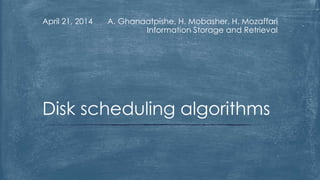
ISR
- 1. A. Ghanaatpishe, H. Mobasher, H. Mozaffari Information Storage and Retrieval April 21, 2014 Disk scheduling algorithms
- 2. Introduction Various Scheduling algorithms FCFS SSTF SCAN C-SCAN N-Step-SCAN, FSCAN LOOK C-LOOK Comparison of Disk Scheduling Algorithms Conclusion Overview
- 3. What is disk scheduling? Servicing the disk I/O requests Why disk Scheduling? Use hardware efficiently Disk scheduling includes Fast access time (seek time+ rotational latency) Introduction
- 4. If desired disk drive is available, request is served immediately. If busy, new request for service will be placed in the queue of pending requests. When one request is completed, the OS has to choose which pending request to service next. I/O requests, OS handling
- 5. To read or write, the disk head must be positioned at the desired track and at the beginning of the desired sector Seek time Time it takes to position the head at the desired track Rotational delay or rotational latency Time its takes for the beginning of the sector to reach the head Data transfer time Data transfer occurs as the sector moves under the head Disk Performance Parameters
- 6. Seek time is the reason for differences in performance For a single disk there will be a number of I/O requests If requests are selected randomly, we will poor performance Disk Scheduling Policies
- 7. Work Queue: 23, 89, 132, 42, 187 There are 200 cylinders numbered from 0 – 199. The disk head stars at number 100. Example
- 8. Process request sequentially. Fair to all processes, no starvation. Approaches random scheduling in performance if there are many processes. First come, first serve(FCFS)
- 9. FCFS Solution Work Queue: 23, 89, 132, 42, 187 Total seek length: 23 − 100 + 89 − 23 + 132 − 89 + 42 − 132 + 187 − 42 = 421
- 10. Select the disk I/O request that requires the least movement of the disk arm from its current position. Always choose the minimum Seek time. Starvation is possible; stay in one area of the disk. If very busy switching directions, slows things down. Not the most optimal. Shortest Service Time First (SSTF)
- 11. SSTF Solution Work Queue: 23, 89, 132, 42, 187 Total seek length: 89 − 100 + 132 − 89 + 187 − 132 + 42 − 187 + 23 − 42 = 263
- 12. Arm moves in one direction only, satisfying all outstanding requests until it reaches the last track in that direction Direction is reversed Sometimes called the elevator algorithm. SCAN
- 13. SCAN Solution Work Queue: 23, 89, 132, 42, 187 Total seek length: 89 − 100 + 42 − 89 + 23 − 42 + 0 − 23 + 132 − 0 + 187 − 132 = 287
- 14. Restricts scanning to one direction only When the last track has been visited in one direction, the arm is returned to the opposite end of the disk and the scan begins again C-SCAN
- 15. C-SCAN Solution Work Queue: 23, 89, 132, 42, 187 Total seek length: 89 − 100 + 42 − 89 + 23 − 42 + 0 − 23 + 199 − 0 + 187 − 199 + 132 − 189 = 368
- 16. Segments the disk request queue into sub queues of length N. Sub queues are processed one at a time, using SCAN. New requests added to other queue when queue is processed. N-step-SCAN
- 17. Two queues One queue is empty for new requests FSCAN
- 18. The LOOK algorithm is the same as the SCAN algorithm in that it also honors requests on both sweep direction of the disk head. The arm goes only as far as final requests in each direction and then reverses direction without going all the way to the end. LOOK
- 19. LOOK Solution Work Queue: 23, 89, 132, 42, 187 Total seek length: 89 − 100 + 42 − 89 + 23 − 42 + 132 − 23 + 187 − 132 = 241
- 20. This is just an enhanced version of C-SCAN. In this, the scanning doesn't go past the last request in the direction that it is moving. It too jumps to the other end but not all the way to the end, Just to the furthest request. C-LOOK
- 21. C-LOOK Solution Work Queue: 23, 89, 132, 42, 187 Total seek length: 89 − 100 + 42 − 89 + 23 − 42 + 187 − 23 + 132 − 187 = 296
- 22. FCFS SSTF SCAN C-SCAN LOOK C-LOOK 421 263 287 368 241 296 Total seek length 84.2 52.6 57.4 73.6 48.2 59.2 Average seek length Comparison of Disk Scheduling Algorithms
- 23. Performance depends on number of requests. SCAN, C-SCAN for systems that place a heavy load on the disk, as they are less likely to cause starvation. Default algorithms, SSTF or LOOK Conclusion
- 24. Operating Systems. William Stalling, 7th edition. Example of Disk Scheduling Algorithms: http://www2.cs.uregina.ca/~hamilton/courses/330/notes/io/node8.html Disk Scheduling, Vaibhav Kumar Gupta http://www4.comp.polyu.edu.hk/~csajaykr/myhome/teaching/eel358/ds.pdf Operating System Concepts. Greg Gagne, Peter Baer Galvin, and Abraham Silberschatz, 8th edition. References